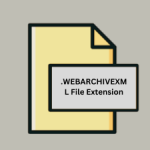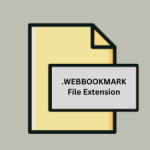.MSPX File Extension

What is an MSPX file?
The .MSPX file extension is used for files that contain ASP.NET pages written in Microsoft’s ASP.NET technology.
ASP.NET is a server-side web application framework designed for web development to produce dynamic web pages.
.MSPX files are essentially ASP.NET pages with the .mspx extension, which are processed by Microsoft’s web server software, Internet Information Services (IIS).
More Information.
The initial purpose of the .MSPX file was to provide a way to utilize the capabilities of ASP.NET for developing web pages and web applications.
ASP.NET was designed to improve upon earlier technologies like ASP (Active Server Pages) by offering a more sophisticated and efficient framework.
It allowed developers to build dynamic web pages with features such as server controls, data binding, and state management.
Over time, ASP.NET evolved, leading to the development of newer technologies and frameworks such as ASP.NET MVC and ASP.NET Core.
Despite these advancements, .MSPX files remain a part of legacy systems where ASP.NET Web Forms are still in use.
They serve the same function as .ASPX files, processing server-side code and rendering dynamic HTML content to users.
Origin Of This File.
The .MSPX file extension originated from Microsoft’s development of ASP.NET, which was introduced as part of the .NET Framework.
The .NET Framework was initially released in 2002, aiming to provide a robust platform for building web applications and services.
The .MSPX file extension itself is a variation of the more common .ASPX file extension, primarily used in applications or environments where .MSPX was preferred for compatibility or organizational reasons.
File Structure Technical Specification.
An .MSPX file is essentially an ASP.NET web page that combines HTML markup with server-side code. The structure of an .MSPX file is designed to facilitate the separation of content and logic:
- HTML Markup: This is the static part of the web page, defining the layout, structure, and presentation of the content.
- Server-Side Code: Embedded within the HTML markup, this code is written in languages supported by ASP.NET, such as C# or VB.NET. It is responsible for handling dynamic content generation, data processing, and server-side logic.
The technical specifications of an .MSPX file include:
- File Extension:
.mspx - Supported Languages: C#, VB.NET
- Execution Environment: ASP.NET runtime, typically running on a Microsoft Internet Information Services (IIS) server.
The file is processed on the server side before being sent to the client’s browser as standard HTML. This allows the server to execute the embedded code, interact with databases, and generate dynamic content.
How to Convert the File?
Converting .MSPX files to other formats typically involve the following steps:
- Convert to ASPX: Since .MSPX is similar to .ASPX, one approach is to rename the .MSPX file to .ASPX. This is often a straightforward process but may require adjustments in the code-behind and web configuration to ensure compatibility.
- Migrate to Modern Frameworks: For a more comprehensive conversion, migrating the functionality of .MSPX files to modern ASP.NET MVC or ASP.NET Core applications may be necessary. This process involves rewriting the application logic and front-end code to align with the new framework’s architecture.
- Export Content: If the goal is to convert the content rather than the code, exporting the HTML output generated by .MSPX pages to static HTML files or other formats might be appropriate.
Advantages And Disadvantages.
Advantages:
- Dynamic Content Generation: .MSPX files allow for the dynamic generation of web content based on server-side logic, enabling interactive and personalized user experiences.
- Integration with .NET Framework: They leverage the full capabilities of the .NET Framework, including robust libraries and tools for development.
- State Management: ASP.NET provides built-in mechanisms for managing state across web requests, which is particularly useful for applications that require user interaction and session persistence.
Disadvantages:
- Legacy Technology: As newer frameworks like ASP.NET MVC and ASP.NET Core have emerged, .MSPX files are considered somewhat outdated and may not benefit from modern advancements in web development.
- Performance Overhead: The use of Web Forms and state management can introduce performance overhead compared to more streamlined approaches available in newer frameworks.
- Learning Curve: Developers familiar with modern web development paradigms might find the Web Forms model of .MSPX files to be less intuitive compared to newer MVC-based approaches.
How to Open MSPX?
Open In Windows
- Visual Studio: Microsoft Visual Studio is the primary development environment for working with .MSPX files. It provides tools for editing, debugging, and managing ASP.NET web applications.
- Text Editors: Basic text editors like Notepad++ or Visual Studio Code can be used to view and edit the raw code of .MSPX files, though they lack the integrated development features of Visual Studio.
Open In Linux
- Development Tools: Similar to MacOS, use cross-platform editors like Visual Studio Code. Tools like Mono may offer limited support for ASP.NET applications.
- Server Setup: Use Mono or Docker with a Windows-based server setup to process
.MSPXfiles.
Open In MAC
- Development Tools: While there is no native support for ASP.NET on MacOS, you can use Visual Studio for Mac or other cross-platform editors with remote development capabilities.
- Server Setup: Use a virtual machine or Docker container running Windows with IIS to process and view
.MSPXfiles.













